#osip brik
Explore tagged Tumblr posts
Text







Love is the Heart of Everything: correspondence between Vladimir Mayakovsky and Lili Brik, 1915-1930
Translated by Julian Graffy Preface, Introduction, and Edited by Bengt Jangfeldt
#epistolary#correspondence#vladimir mayakovsky#lili brik#osip brik#historical#julian graffy#bengt jangfeldt#love is the heart of everything 1987#russian literature#polyamory#(kind of??)#queer#my post#image#described
7 notes
·
View notes
Text
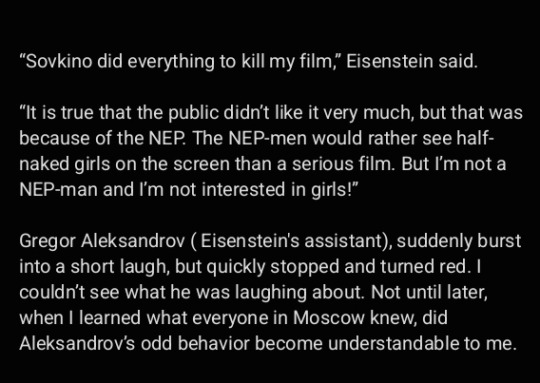

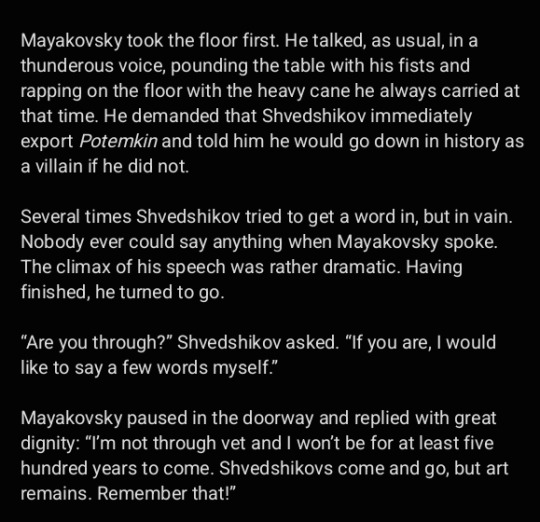
Vladimir Mayakovsky defending his friend, Sergei Eisenstein, from censorship over nonsense. From an account by Waclaw Solski.
Sergei Eisenstein is now widely considered one of the greatest filmmakers of all time. The Battleship Potemkin, the film that this scuffle was about, is now considered one of the best films of all time. Sergei Eisenstein was also queer. It's hard to put an exact modern label on the sexuality of someone who lived one hundred years ago, but I think "gay ace" is a good fit.
He had no interest in women. He had very little interest in sex. He got in trouble a few times for returning to the Soviet Union from western Europe with hand drawn homoerotic scenes from drag bars in his luggage.
Vladimir Mayakovsky was truly "The Poet of The Revolution." His commitment to the Bolshevik cause is not in doubt. His relationship with the state after the Revolution was complicated and full of struggles with censorship. After shooting himself in 1930, his poems have been used to sell everything from toothpaste to gulags. You're as likely to see old posters with his words promoting the benefits of exercise as you are modern ones justifying Russian actions in Ukraine.
Mayakovsky had a Ukranian mother. He survived solitary confinement in prison as a child. He was only educated to the fifth grade. He spoke Georgian better than Russian. He was not monogamous and never married. He shared the love of his life(Lilya Brik) with her husband( Osip Brik) , whom he also had an eccentric sort of love for. Eisenstein wasn't even the only queer artist he stood up for.
You needed a friend with good Bolshevik credentials to find a place to live as an artist in those days. He aided poet Sophia Parnok, AKA The Russian Sappho, in escaping the first Soviet Ukranian Famine by supplying her with a reference. The authorities at the time really hated her for her lesbian poetry and eccentric personality, but a reference like Mayakovsky was solid gold.
The bourgeoisie loves dressing its actions up in revolutionary costumes and then retrofitting historical figures into perfect puppets.
Don't believe them. It's not revolutionary to glorify the Czars and bully the Gays.
Be a Mayakovsky, not a Vatnik.
13 notes
·
View notes
Text
Lili diventa il sole intorno a cui ruota ogni suo pensiero. Non solo è la sua musa, ma lo aiuta concretamente trascrivendo le sue opere e occupandosi della diffusione tra gli editori. Durante un viaggio in Lettonia, paese d’origine della madre, fa di tutto perché alcuni lavori del suo Volodja vengano pubblicati. Tra una questione pratica e l’altra, però, si fa strada la gelosia. Sono lontani, inquieti e pieni di dubbi quando le lettere tardano: “Se non scriverai nulla di te io impazzirò” scrive lui. E lei: “Non tradirmi! Ho una terribile paura di questo”. Ogni volta che si trovano in città diverse – Riga, Londra, Berlino, Mosca, Soči – si ripetono l’amore e il terrore di perdersi: “io ti amo un milione di volte di più di tutti gli altri messi insieme.” Quando è Lili a essere via, Osip e Volodja si dicono che la vita senza di lei sembra senza senso: “Ogni mattina vado da Osja e gli dico: ‘Si sta male, fratello Gatto, senza Liska’ e Oska risponde: ‘Si sta male, fratello Cucciolo, senza la Micia’” scrive il poeta a Lili nel 1921.
Di Majakovskij e Lili Brik
3 notes
·
View notes
Text
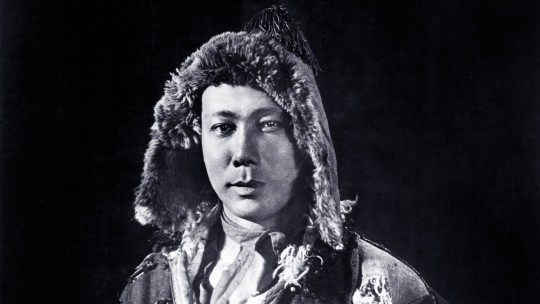
Valéry Inkijinoff in Storm Over Asia (Vsevolod Pudovkin, 1928)
Cast: Valéry Inkijinoff, I. Didintseff, Aleksandr Chistyakov, Victor Tsoppi, Fyodor Ivanov, V. Pro, Boris Barnet, Karl Gurniak, I. Inkizhinov, V. Belinskaya, Anel Sudakevich. Screenplay: Osip Brik, Ivan Novokshenov. Cinematography: Anatoli Golovnya. Art direction: M. Aronson, Sergei Kozlovsky.
The great silent Russian propaganda films depended heavily on two things the nascent Soviet Union had in abundance: faces and landscapes. This reliance on closeups and sweeping views of fields and plains sometimes resulted in a loss of narrative coherence, but put the emphasis on the people and resources that the Bolsheviks needed to exercise control over. Storm Over Asia is no exception, beginning with the windswept land and Asiatic faces of the Mongol peoples of eastern Russia, which at the time depicted in the film was still a vast battleground for the Bolsheviks and European forces. After establishing the location, the film focuses on Bair (Valéry Inkijinoff), a young hunter whose father sends him off to the bazaar to sell a silver fox pelt. In the vividly filmed bazaar, Bair is cheated by an unscrupulous European fur trader (Viktor Tsoppi), who might as well be wearing a label: bourgeois capitalist. Beaten by the henchmen for the trader, Bair escapes and joins a group of Soviet partisans fighting the occupiers. The occupation forces seem to be British, who were never a significant presence in this part of the Soviet Union, but the film is vague about such details. They manage to capture Bair, who is sent out with a soldier to be shot, but when they examine Bair's belongings they discover an ancient document indicating that he's a direct descendant of Genghis Khan. (The original title of the film, in Russian, was The Heir to Genghis Khan.) They find the wounded Bair, restore him to health, and set him up as the puppet ruler of a Mongolian state. In the end, Bair turns against the imperialists and the film concludes with a literal storm sweeping them away. It's a film full of great set-pieces, including a montage mockng the imperialists and their wives as they put on their finery and then are driven on a muddy road to meet the new Grand Lama. After an elaborate ceremony (actually filmed at a Tibetan Buddhist celebration) the lama turns out to be a small boy, not at all impressed with his visitors.
2 notes
·
View notes
Text
Majakovskij: ribelle dolce e crudele. Di Rosaria Spinelli
<<Quando si è ucciso Majakovskij, è morto un grande poeta. Ma quando è morto Osip, sono morta io.>>*Confidenza dell’attrice Lilia Brik resa pubblica dopo la morte del marito Osip, che rivela come la sfrenata passione nutrita nei suoi confronti da Vladímir Majakóvskij (Bagdati, 1893 – Mosca, 1930) non fosse da lei corrisposta. Secondo i biografi, fu proprio questo amore disperato, assieme alla…
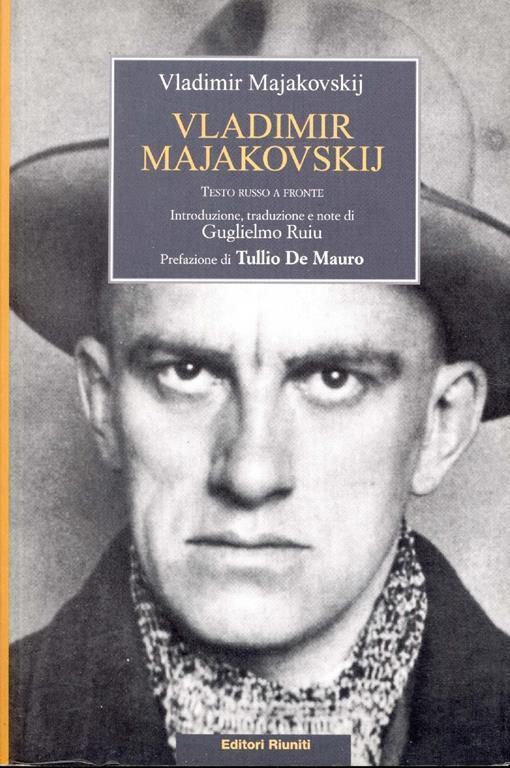
View On WordPress
0 notes
Text
Catresponse
In this Constructivist poster from 1925, the woman calling is Lili Brik, wife of the Formalist literary theorist Osip Brik and mistress of the poet Alexander Mayakovsky. A merely literal translation, the words without the jazz, is, “Leningrad State Publisher BOOKS for all branches of knowledge.” The photography and the graphic design are by Alexander Rodchenko, whose AR monogram appears in the…

View On WordPress
0 notes
Text

Gustav Klutsis, "Postcard for the All-Union Spartakaida Sporting Event," 1928
Some Soviet Futurist artists like Osip Brik declared painting to be an obsolete art form due to photography, which led the early Soviet modern art movement to revolutionize photomontage as an art form. I love this one in particular it's very fun
1 note
·
View note
Photo

Osip Brik (writer), 1924 - by Alexander Rodchenko (1891 - 1956), Russian
108 notes
·
View notes
Text

Norderney
Zwei am Strand , 1923. Sitzen da, als ob sie Flussgötter werden wollten, anders als die bisherigen Flussgötter. Das ist das Jahr, in dem Shklovskys Zoo oder Briefe, nicht über die Liebe entsteht, ein Buch, das auch als ein seltsames Spiegelvorbild zu Benjamins Spanischer Reise Moskauer Tagebuch lesbar ist.
#Ви́ктор Бори́сович Шкло́вский#Nach dem Gesetz#Osip Brik#Владимир Владимирович Маяковский#Осип Максимович Брик
6 notes
·
View notes
Photo

Osip Brik, unpublished illustration by Alexander Rodchenko for the cover of the magazine LEF, 1924. Gouache on gelatin-silver print, 23.6 x 18 cm.
instagram.com/litrussa
23 notes
·
View notes
Photo

(553)
camacio70: Debbie Harry; i12bent: Osip Brik, Jan. 16, 1888 – 1945: Russian avant garde writer and literary critic; celebnudes4u: Sissy Spacek
(via triptychon64)
Uncensored: triptych193.wordpress
7 notes
·
View notes
Photo

Alexander Rodchenko - Caricature Showing Osip Brik, variant of a cover for LEF Magazine 1924 - Gelatin-silver print - 24.2 x 17.9 cm - Private collection - © Rodchenko’s Archive - 2011, ProLitteris, Zurich
10 notes
·
View notes
Quote
Our cultural creative work is now entirely purpose-oriented. We do not think up for ourselves any cultural work that does not pursue some definitive practical aim. The concepts of ‘pure science’, 'pure art’, and ‘self-valuable truths and beauties’ are foreign to us. We are practicians, - and in this lies the distinguishing feature of our cultural consciousness.
Osip Brik (1888-1945), ‘From Picture to Calico-Print’. Originally published in LEF, no. 6, Moscow, 1924.
Written in constructivist-productivist Russian times, almost precisely a full century ago. Did we just go a clean 180, with the current general critique on (Dutch) neoliberal policy instrumentalising the arts into something ‘useful’?
1 note
·
View note
Text
last night i had a dream that i was chillin with osip brik
#like i was walking on the street at night in a huge filthy city and i was gonna have to wait like an hour for the bus#and there was this dude hitting on me under a buzzing orange streetlamp where i was trying to stand and he was annoying but he was like#'hey lemme buy you a coffee' and i was like 'okay fine' cause i didn't want to be alone with this dude so we ducked into a cafe#and behind the bar was fuckin. osip brik#and we got into a convo and iced out the other dude and eventually he got bored and left#i saw him flirting with another girl but she was into it so alright#and then we just hung out and talked a bit more and i finished my coffee and went out to catch my bus and woke up#gg osip brik#what a quality dream character#ros.txt
4 notes
·
View notes
Photo
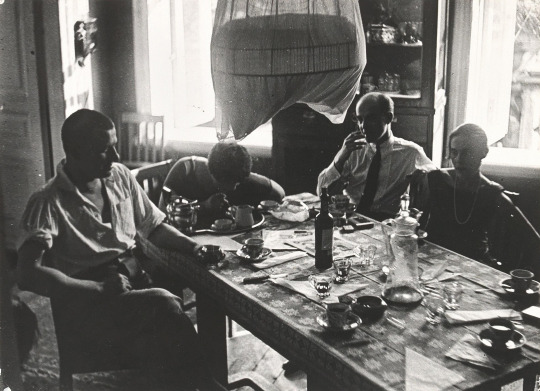
Morning in the Mayakovsky-Briks apartment in Petersburg. Present: Vladimir Mayakovsky, Varvara Stepanova, Osip Beskin, Lilya Brik. Photo by Aleksandr Rodchenko (1926).
191 notes
·
View notes
Photo

Osip e Lili Brik insieme a Vladimir Majakovskij
24 notes
·
View notes